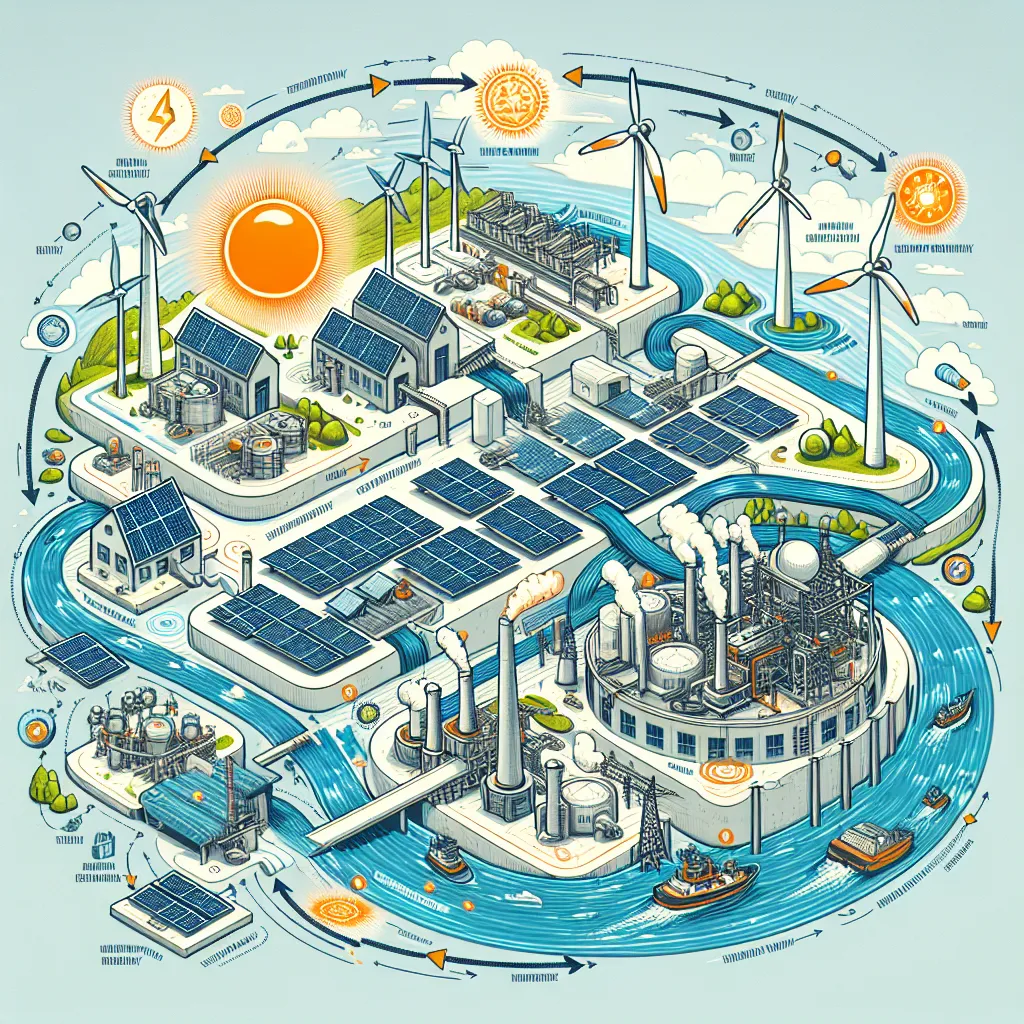The IELTS Reading test is a crucial component of the IELTS exam, assessing candidates’ ability to comprehend complex texts and extract relevant information. In this article, we’ll explore a sample IELTS Reading test focusing on “The rise of renewable energy in industrial applications.” This topic is not only relevant to current global trends but also provides an excellent opportunity to practice various question types typically found in the IELTS Reading test.
Table Of Contents
 Renewable Energy in Industry
Renewable Energy in Industry
IELTS Reading Practice Test
Passage 1 – Easy Text
Renewable energy has become increasingly important in industrial applications over the past few decades. As concerns about climate change and environmental sustainability grow, many industries are turning to renewable energy sources to power their operations. This shift is not only beneficial for the environment but also offers economic advantages in the long run.
Solar energy is one of the most widely adopted forms of renewable energy in industrial settings. Photovoltaic panels can be installed on factory rooftops or in nearby fields, providing a reliable source of electricity during daylight hours. Wind power is another popular option, especially for industries located in areas with consistent wind patterns. Offshore wind farms have become particularly attractive for coastal industrial facilities.
Hydroelectric power, while not a new technology, continues to play a significant role in industrial energy production. Many factories situated near rivers or dams benefit from this clean and constant energy source. Biomass energy, derived from organic materials such as wood chips or agricultural waste, is gaining traction in industries that produce organic byproducts.
The adoption of renewable energy in industrial applications is not without challenges. Intermittency issues associated with solar and wind power require innovative storage solutions. Additionally, the initial investment costs can be high, although they are often offset by long-term savings and government incentives.
Despite these challenges, the trend towards renewable energy in industry is clear. As technology improves and costs decrease, more companies are likely to embrace these sustainable energy sources, contributing to a cleaner and more efficient industrial sector.
Questions 1-5
Do the following statements agree with the information given in the passage?
Write
TRUE if the statement agrees with the information
FALSE if the statement contradicts the information
NOT GIVEN if there is no information on this
- Renewable energy use in industry has decreased in recent years.
- Solar panels can be installed both on factory roofs and in nearby areas.
- Offshore wind farms are less efficient than onshore wind farms for industrial use.
- Hydroelectric power is a relatively new technology in industrial applications.
- The initial costs of implementing renewable energy systems are always lower than traditional energy sources.
Questions 6-10
Complete the sentences below.
Choose NO MORE THAN TWO WORDS from the passage for each answer.
- ___ panels are commonly used to harness solar energy in industrial settings.
- Industries near the coast often benefit from ___ wind farms.
- ___ is still an important renewable energy source for factories near water bodies.
- Energy derived from organic materials like wood chips is called ___ energy.
- The ___ of solar and wind power is a challenge that requires advanced storage solutions.
Passage 2 – Medium Text
The integration of renewable energy into industrial processes represents a significant shift in how businesses approach their energy needs and environmental responsibilities. This transition is driven by a combination of factors, including technological advancements, economic incentives, and increasing environmental regulations.
One of the key drivers of renewable energy adoption in industry is the dramatic reduction in costs associated with these technologies. Over the past decade, the price of solar panels and wind turbines has fallen substantially, making them competitive with, and in some cases cheaper than, traditional fossil fuel-based energy sources. This cost reduction has been accompanied by improvements in efficiency, making renewable energy systems more viable for large-scale industrial applications.
The industrial sector’s embrace of renewable energy extends beyond simply purchasing green electricity from the grid. Many companies are now investing in their own renewable energy infrastructure. For instance, on-site solar installations have become increasingly common in manufacturing facilities, warehouses, and data centers. These installations not only reduce reliance on the grid but also provide a hedge against future energy price fluctuations.
Another emerging trend is the use of renewable energy in process heat applications. Traditionally, industrial processes requiring high temperatures have relied heavily on fossil fuels. However, innovations in concentrated solar power and geothermal technologies are beginning to offer alternatives. For example, some food processing plants are now using solar thermal systems for pasteurization and sterilization processes.
The adoption of renewable energy in industry also aligns with the growing emphasis on corporate social responsibility and sustainability reporting. Many large corporations have set ambitious targets for reducing their carbon footprint, and transitioning to renewable energy is a key strategy in achieving these goals. This shift not only improves a company’s environmental credentials but can also enhance its reputation among consumers and investors who increasingly value sustainable business practices.
However, the transition to renewable energy in industrial applications is not without challenges. The intermittent nature of some renewable sources, particularly solar and wind, poses difficulties for industries that require constant, reliable power. This has led to increased interest in energy storage technologies, such as advanced batteries and hydrogen fuel cells, which can help balance supply and demand.
Furthermore, the integration of renewable energy often requires significant changes to existing industrial processes and infrastructure. This can involve substantial upfront costs and potential disruptions to operations during the transition period. As a result, many industries are adopting a phased approach, gradually increasing their renewable energy capacity over time.
Despite these challenges, the trend towards renewable energy in industrial applications appears to be accelerating. Governments worldwide are implementing policies to encourage this transition, including tax incentives, grants, and renewable energy mandates. As these policies evolve and technologies continue to improve, it is likely that renewable energy will play an increasingly central role in powering the world’s industries in the coming decades.
Questions 11-14
Choose the correct letter, A, B, C, or D.
-
According to the passage, which of the following is NOT mentioned as a factor driving the adoption of renewable energy in industry?
A) Technological advancements
B) Economic incentives
C) Environmental regulations
D) Consumer demand -
The text suggests that on-site solar installations in industrial facilities:
A) Are less efficient than grid-supplied electricity
B) Provide protection against energy price changes
C) Are only suitable for small-scale operations
D) Increase reliance on the electrical grid -
Which of the following is presented as a challenge in adopting renewable energy for industrial use?
A) Lack of government support
B) Decreasing efficiency of renewable technologies
C) Intermittent nature of some renewable sources
D) Oversupply of renewable energy -
The passage indicates that the integration of renewable energy in industry often:
A) Results in immediate cost savings
B) Requires no changes to existing processes
C) Involves significant upfront investments
D) Is completed in a single step
Questions 15-19
Complete the summary below.
Choose NO MORE THAN TWO WORDS from the passage for each answer.
The adoption of renewable energy in industrial applications is growing due to several factors. Over the past decade, there has been a significant (15) in the cost of technologies like solar panels and wind turbines. Many companies are investing in (16) solar installations, which can reduce dependence on the grid. Innovations in concentrated solar power and geothermal technologies are enabling the use of renewable energy for (17) . This shift aligns with an increased focus on (18) and sustainability reporting in the corporate world. However, the transition faces challenges, including the (19) ___ of some renewable energy sources, which has led to greater interest in energy storage solutions.
Passage 3 – Hard Text
The paradigm shift towards renewable energy in industrial applications is not merely a trend but a fundamental reimagining of energy systems that underpins modern manufacturing and production processes. This transition is characterized by its multifaceted nature, encompassing technological innovation, policy frameworks, market dynamics, and a recalibration of industrial strategies in the face of climate change and resource scarcity.
At the forefront of this transformation is the concept of industrial symbiosis, where waste or byproducts from one industrial process become inputs for another, creating closed-loop systems that maximize resource efficiency. In the context of renewable energy, this principle is being applied to create integrated energy ecosystems. For instance, excess heat from solar thermal systems in one factory might be used to power absorption chillers in a neighboring facility, while biogas produced from organic waste streams could fuel combined heat and power plants serving multiple industries in an eco-industrial park.
The integration of renewable energy into industrial processes is also driving innovation in smart grid technologies and demand response systems. These advanced networks allow for bidirectional flow of electricity and information, enabling industries to optimize their energy consumption patterns in real-time based on the availability of renewable resources. This flexibility is crucial for managing the variability inherent in many renewable energy sources and can significantly enhance the overall stability and resilience of energy systems.
Moreover, the shift towards renewable energy is catalyzing the development of novel industrial processes that are inherently more compatible with clean energy sources. Electrification of heat is one such frontier, where technologies like electric arc furnaces and electromagnetic heating are being refined to replace fossil fuel-based heating in energy-intensive industries such as steel and cement production. Similarly, green hydrogen produced through electrolysis powered by renewable electricity is emerging as a promising feedstock for chemical manufacturing and as a reducing agent in steelmaking, offering pathways to decarbonize industries that have traditionally been heavily reliant on fossil fuels.
The economic implications of this transition are profound and multifaceted. While the initial capital costs of renewable energy systems can be substantial, the long-term operational expenses are often significantly lower than traditional fossil fuel-based systems. This shift in cost structure is prompting a reevaluation of long-term energy contracts and power purchase agreements (PPAs) in many industries. Furthermore, the localization of energy production through distributed renewable systems is reshaping industrial geography, potentially revitalizing areas with abundant renewable resources but historically disadvantaged by their distance from fossil fuel sources.
However, the transition also presents formidable challenges, particularly in energy-intensive industries where the sheer scale of energy demand can overwhelm the capacity of current renewable technologies. The intermittency issue remains a significant hurdle, necessitating substantial investments in energy storage technologies and smart load management systems. Additionally, the embedded carbon in existing industrial infrastructure represents a form of carbon lock-in that can slow the transition to renewable systems.
The regulatory landscape plays a crucial role in shaping this transition. Carbon pricing mechanisms, such as emissions trading schemes and carbon taxes, are increasingly influencing industrial energy choices by internalizing the environmental costs of fossil fuel use. Renewable portfolio standards and feed-in tariffs have been effective in creating markets for renewable energy, while green certificates and guarantees of origin are facilitating the trade of renewable energy attributes across borders.
As industries grapple with these changes, new business models are emerging. Energy service companies (ESCOs) are playing an increasingly important role, offering comprehensive energy management solutions that integrate renewable sources, energy efficiency measures, and smart grid technologies. The concept of virtual power plants, which aggregate distributed energy resources to provide grid services, is gaining traction, allowing industries to monetize their energy assets in new ways.
The global nature of industrial supply chains adds another layer of complexity to the renewable energy transition. Scope 3 emissions, which include all indirect emissions in a company’s value chain, are becoming a focus area for many industries. This is driving efforts to decarbonize not just direct operations but entire supply chains, leading to collaborative initiatives between companies to develop renewable energy projects that benefit multiple stakeholders.
In conclusion, the rise of renewable energy in industrial applications represents a fundamental shift in how we conceptualize and operate our productive systems. It is a transition that goes beyond simple fuel switching, encompassing changes in processes, business models, and industrial ecosystems. As this transition accelerates, it promises to reshape the global industrial landscape, potentially realigning competitive advantages and opening new avenues for sustainable economic growth.
Questions 20-23
Choose the correct letter, A, B, C, or D.
-
According to the passage, industrial symbiosis in the context of renewable energy involves:
A) Competing industries sharing energy resources
B) Using waste from one process as input for another
C) Developing new types of renewable energy
D) Increasing dependency on fossil fuels -
The text suggests that smart grid technologies in industrial settings:
A) Are incompatible with renewable energy sources
B) Reduce the overall energy consumption of industries
C) Allow for real-time optimization of energy use
D) Eliminate the need for traditional power sources -
Which of the following is NOT mentioned as a challenge in the transition to renewable energy in industry?
A) The intermittency of some renewable energy sources
B) The high energy demand of certain industries
C) The embedded carbon in existing infrastructure
D) The lack of technological innovations -
The passage indicates that carbon pricing mechanisms:
A) Have no effect on industrial energy choices
B) Discourage the use of renewable energy
C) Help internalize environmental costs of fossil fuels
D) Are being phased out in most countries
Questions 24-26
Complete the sentences below.
Choose NO MORE THAN THREE WORDS from the passage for each answer.
- The process of using electricity to produce heat in industries like steel and cement production is known as ___.
- ___ produced using renewable electricity is emerging as a promising alternative in chemical manufacturing and steelmaking.
- The concept of ___ allows industries to aggregate distributed energy resources and provide services to the grid.
Questions 27-30
Do the following statements agree with the claims of the writer in the passage?
Write
YES if the statement agrees with the claims of the writer
NO if the statement contradicts the claims of the writer
NOT GIVEN if it is impossible to say what the writer thinks about this
- The transition to renewable energy in industry is primarily driven by short-term cost savings.
- Energy service companies are becoming more important in managing industrial energy systems.
- The use of renewable energy in industry always results in immediate reductions in carbon emissions.
- The global nature of industrial supply chains complicates the transition to renewable energy.
Answer Key
Passage 1
- FALSE
- TRUE
- NOT GIVEN
- FALSE
- FALSE
- Photovoltaic
- offshore
- Hydroelectric power
- biomass
- intermittency
Passage 2
- D
- B
- C
- C
- reduction
- on-site
- process heat applications
- corporate social responsibility
- intermittent nature
Passage 3
- B
- C
- D
- C
- Electrification of heat
- Green hydrogen
- virtual power plants
- NO
- YES
- NOT GIVEN
- YES
Conclusion
This IELTS Reading practice test on “The rise of renewable energy in industrial applications” offers a comprehensive exploration of this important topic while challenging your reading comprehension skills. By tackling various question types and difficulty levels, you can enhance your preparation for the IELTS exam.
Remember, success in the IELTS Reading test requires not only understanding complex texts but also managing your time effectively. Practice regularly with diverse topics and question types to improve your performance. For more IELTS preparation resources, check out our articles on how renewable energy is reducing carbon footprints and the impact of clean energy on the industrial sector.
Good luck with your IELTS preparation!



